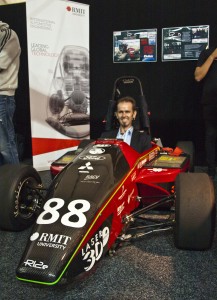
SAE-A Executive Director, Geoff Pearson, sitting in RMIT's electric car at the Grand Prix. Photo: Jose Paolo Abletez
Red Bull, Lotus, Ferrari and RMIT might not appear to have a whole lot in common, but the latter is rapidly gaining respect for its breakthroughs in the racing industry.
This year RMIT’s racing teams were represented at the Formula 1 Grand Prix Educational Expo, alongside universities from across Australia who compete in the Formula Society of Automotive Engineers Australasia (FSAE-A).
What is the FSAE-A?
- Competition involving thousands of university students from Australia and neighbouring countries
- Teams are expected to design, build and compete in a small high-performance racecar within under a year
A promo video for E-racing from May, 2012
RMIT students have competed for the past 12 years racing a petrol-powered racecar, but since 2010 have entered a second, and relatively unknown, electric team.
Professor Simon Watkins, who set-up RMIT racing in 2000, has worked alongside the electric team for the past three years.
“We built arguably the world’s first all electric SAE car, which was a conversion of a previous petrol car,” he said.
“There were no rules internationally for formula SAE electric racing, so we pushed and shoved and… (In 2010) we demonstrated it, it completed many laps of the circuit, almost silently, and turned quite a few petrol heads.”
RMIT developed a philosophy for sustainability stemming from the idea that they would charge up the car’s batteries with renewable energy from the sun, that is, from RMIT’s renewable energy park.
Since their debut in 2010, RMIT e-racing have enjoyed multiple successes- winning by default as the only electric car in their first year, beating Swinburne in 2011 and coming second in 2012.
Now in 2013 at least three universities will be entering an electric car in the Formula SAE-A.
Deadlines, schedules and sacrifices…
The RMIT petrol and electric teams have experienced national and international recognition for their hard work, but there have been years where the students have been overly ambitious.
“The biggest thing the students learn at the end of the competition is the irreversible nature of time and money,” Mr Watkins said.
E-racing Team Leader, Nitharssna Sanmugasundram, co-manages a group of 63 students this year who have to simultaneously juggle a job, course work and a social life.
“It is a bit of a struggle sometimes, but it’s also a practical crash course in time management and efficiency,” said team member Brenton Chivers.
The RMIT students who build these cars acquire a transferable and industry-sought skill set that contributes to the sustainable future of race cars around the globe.






